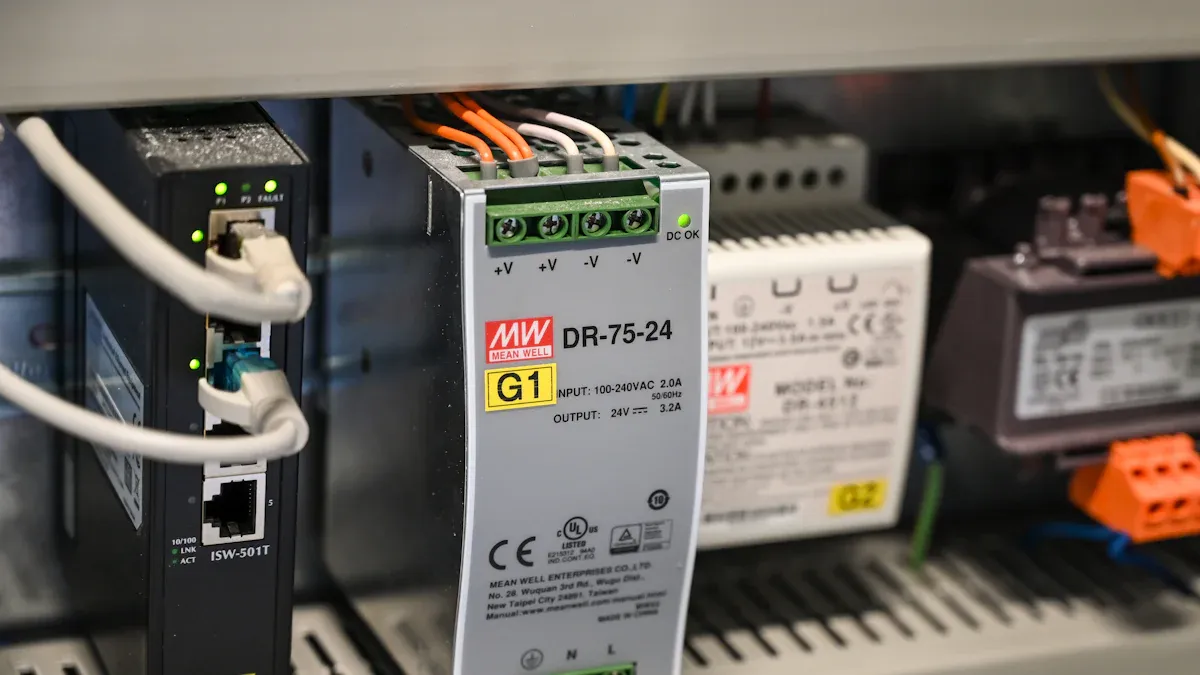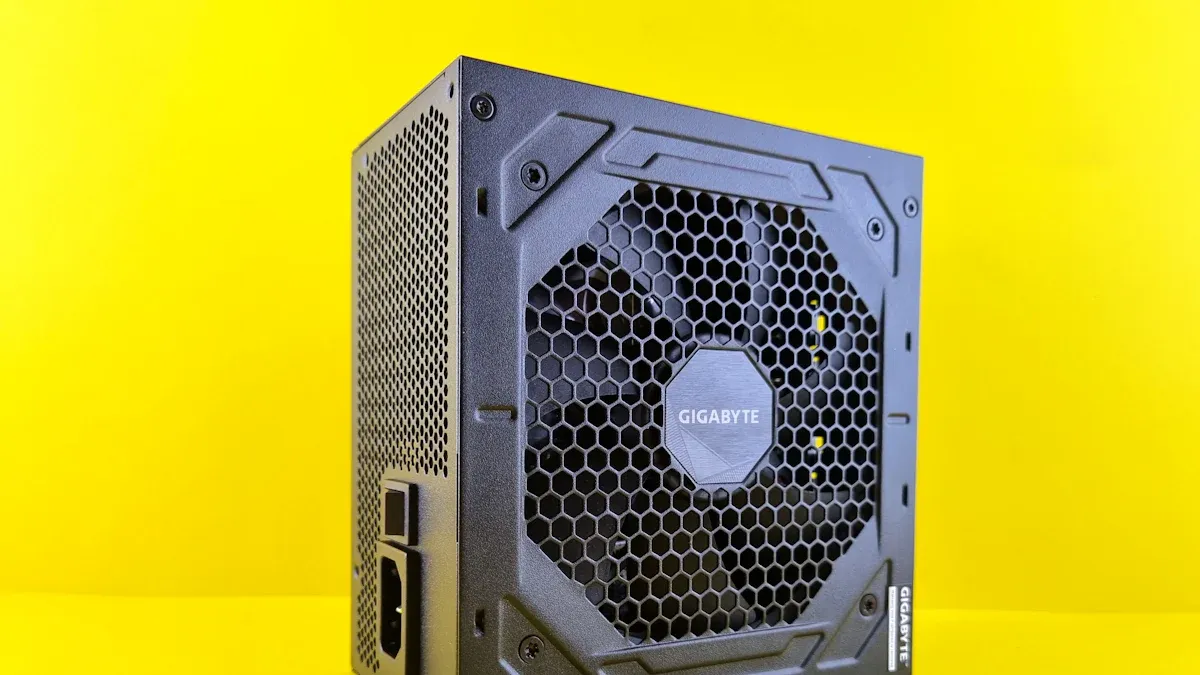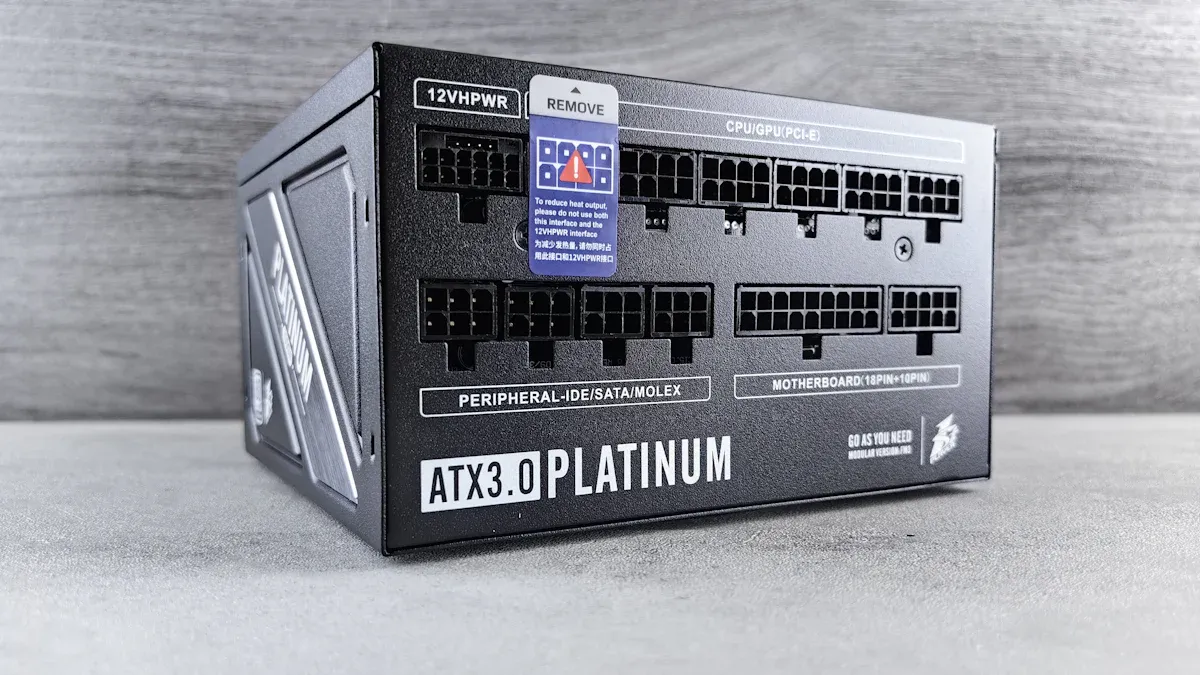How to Choose the Best Industrial Power Supply for Your Needs

Industrial power supplies are important for keeping systems working well. Picking the right one avoids expensive problems and helps key operations run smoothly. For instance, a good power supply uses less energy and makes less heat. This saves money and helps machines last longer. Over time, parts wear out—after 1 million hours, only 36.7% still work. Choosing a properly sized and high-quality power supply ensures better performance and saves money in the long run for industrial use.
Key Takeaways
Figure out how much power you need. Check voltage, current, and power to keep your equipment safe and working well.
Pick a strong and eco-friendly power supply. Choose ones made with tough materials and designs that handle tough conditions.
Think about what your power supply will power. Different devices need different voltage and stability to work their best.
Look for safety labels like UL and CE. These show the power supply is safe and protects your devices.
Plan ahead by getting a modular power supply. This makes it easy to upgrade or change as your system grows.
Identify Your Application’s Power Requirements
Voltage, Current, and Power Needs
Knowing the voltage, current, and power needs is very important. Different industries need different voltage levels, from under 1,000 V to over 4,000 V. For example, telecom systems often need over 4,000 V for smooth energy flow. Offshore platforms, like oil rigs, also use high voltage to work in faraway places.
Machines in factories can have very different power needs. A study in Suzhou showed how building types and work conditions affect energy use. This five-year study proves that matching power supplies to specific needs is key. Think about both peak and regular loads to avoid problems with performance.
Environmental Conditions and Durability
The environment affects how long a power supply lasts. Tough conditions like extreme heat, humidity, or chemicals can damage equipment. To handle this, choose models made with strong materials and protective designs like IP-rated cases.
Durability also includes environmental impact. Things like global warming potential (GWP) and ozone depletion potential (ODP) show how eco-friendly a power supply is. Below is a table of key environmental factors:
Metric | Units | What it measures |
|---|---|---|
Water use | m³ | Water used during making and using the product |
Land use | acre | Land needed for the product's lifecycle |
Global Warming Potential | kgCO₂-eq | Greenhouse gases causing global warming |
Ozone Depletion Potential | kgCFC11-eq | Damage to the ozone layer |
Human Toxicity Potential | 1,4-DCB-eq | Harmful effects of toxic substances on people |
Pick a power supply that lasts long and is eco-friendly. This helps your equipment work well and supports sustainability.
Load Types and Stability Requirements
The type of load affects what your power supply needs. Loads can be resistive, inductive, or capacitive, each needing different support. Resistive loads, like heaters, need steady voltage. Inductive loads, like motors, need to handle sudden current spikes. Capacitive loads, found in circuits, need stable voltage to protect parts.
Stability is very important for precise industrial work. For example, automated machines need power supplies with low noise and steady output. This keeps them running smoothly and avoids breakdowns. Look for power supplies with advanced features to keep output consistent.
Types of Industrial Power Supplies

Knowing the types of industrial power supplies is important. Each type has special features for different needs.
Linear vs. Switching Mode Power Supply
Linear and switching power supplies are common in industries. Linear power supplies are simple and make very little noise. They work well for sensitive devices like analog circuits. But they waste energy as heat, making them less efficient. This heat means they need big heat sinks and transformers, which adds size and weight.
Switching power supplies are much more efficient, often 80-90% or more. They use high-frequency parts, so they are smaller and lighter. They can create more noise, but filters can fix this. These power supplies are cheaper for high-power needs and are popular for their small size and energy savings.
Feature | Linear Power Supplies | Switching Power Supplies |
|---|---|---|
Efficiency | Wastes energy as heat; less efficient. | Very efficient; 80-90% or more. |
Size and Weight | Big and heavy. | Small and light. |
Noise and Ripple | Very quiet; good for sensitive devices. | Louder; needs filters. |
Heat Dissipation | Makes a lot of heat. | Makes less heat. |
Cost | Costs more. | Cheaper for high-power uses. |
AC-DC and DC-DC Converters
AC-DC and DC-DC converters help meet power needs. AC-DC converters change grid power (AC) into device power (DC). They are used in things like computers and TVs. These converters are common because electronics are everywhere now.
DC-DC converters adjust DC voltage for different devices. They are important for things needing exact voltage, like phones or cars. Both types make sure devices get steady and reliable power.
Redundant and Uninterruptible Power Supplies
Redundant and uninterruptible power supplies (UPS) stop power problems. Redundant power supplies keep systems running by avoiding single failures. They are great for systems that must always work.
UPS systems switch power sources to stop outages. They don’t give constant power like redundant systems but help during repairs. Both types improve reliability and stop unexpected power issues.
Power Supply Type | Reliability Features | Impact on Downtime |
|---|---|---|
Redundant Power Supplies | Always gives power; no single failure stops it. | Keeps systems running all the time. |
Uninterruptible Power Supply | Switches power sources to avoid outages. | Helps during repairs or failures. |
By learning about these power supplies, you can pick the best one for your needs.
Key Factors for Choosing the Right Power Supply
Input and Output Specifications
To pick the right power supply, match its input and output to your needs. First, check the input voltage range. Some power supplies work with many voltage levels, making them useful in different places or with unstable power. For example, a power supply with an 85-264V AC range works with both 110V and 220V systems.
Next, look at the output voltage and current. Make sure the power supply gives the exact voltage your equipment needs. Too much or too little voltage can harm sensitive parts. Also, the output current must meet or go beyond what your devices need. If you have many parts, add up their current needs to avoid overloading the power supply.
Finally, think about the power factor. A high power factor uses energy better and lowers electricity costs. Many industrial power supplies now have power factor correction (PFC) to save energy and meet rules.
Efficiency and Noise Considerations
Efficiency is key for saving energy and cutting costs. Modern power supplies waste less energy, lowering bills and helping the environment. New materials like Silicon Carbide (SiC) and Gallium Nitride (GaN) make power supplies more efficient. They also create less heat, so smaller cooling systems are needed.
Noise is also important, especially for precise work. High-frequency switching can cause electrical noise, which may harm sensitive devices. Many power supplies now have filters to reduce noise and keep output steady. Choosing a low-noise power supply protects your equipment and ensures it works well.
Tip: Choose power supplies with at least 80% efficiency and low Total Harmonic Distortion (THD) for energy savings and less noise.
Form Factor and Mounting Options
The size and mounting of a power supply affect how it fits and works. Small designs save space and fit into tight spots. Modular power supplies let you add or replace parts as needed.
Good mounting helps the power supply last longer. Experts check several things during setup:
Follow bolt torque rules to avoid damage.
Use materials that match the mounting surface and keep isolation.
Make sure there’s room for future maintenance.
Check for environmental risks like heat or moisture.
Look at vibration levels to choose the right mounts.
Plan for shock loads to protect during sudden impacts.
Think about temperature changes when picking materials.
Spread the load evenly across mounts.
Match natural frequency to ensure proper isolation.
By considering these points, you can install the power supply securely and make it last longer.
Safety Certifications and Compliance
Safety certifications are important for making sure industrial power supplies work safely and follow global rules. When picking a power supply, check if it has the right certifications. These prove the product passed strict tests and meets safety, health, and environmental standards.
Here are some key certifications to know:
Certification/Standard | What It Ensures |
|---|---|
IEC 62368-1 | Uses safety rules to lower risks in product design. |
CE Mark | Shows the product meets safety and environmental laws. |
UL Mark | Confirms the product follows safety rules set by Underwriters Laboratories. |
The IEC 62368-1 standard is very useful for industrial power supplies. It focuses on safety design to reduce risks during use. The CE Mark is needed for products sold in Europe, showing they meet safety and environmental rules. The UL Mark proves the product is safe and reliable, giving users confidence.
Think about where the power supply will be used when checking certifications. For example, if the equipment works in risky places, look for extra certifications like ATEX or IECEx. These ensure safe use in explosive areas.
Tip: Always read the product details to check certifications. This helps avoid problems and ensures the power supply is safe for your needs.
Reliability and Brand Reputation
Reliability is key for industrial power supplies. A reliable power supply reduces downtime, lowers repair costs, and works consistently. To check reliability, look at the Mean Time Between Failures (MTBF). Higher MTBF means the product lasts longer, which is important for industrial work.
The brand also matters when choosing a power supply. Well-known brands often make high-quality products. They spend time improving safety, durability, and efficiency. Brands like Siemens, Schneider Electric, and ABB are trusted for their reliable power supplies.
Check customer reviews to learn about the product’s performance. Positive feedback shows the product works well and lasts long. Also, pick brands with good warranties and customer support. These features show the company trusts its product and gives you extra protection.
Note: Trusted brands may cost more, but they save money over time by needing fewer repairs or replacements.
By focusing on reliability and choosing good brands, you ensure your industrial power supplies work well and meet your needs.
How to Select and Size a Power Supply

Calculating Power Capacity and Safety Margins
To pick the right power supply, calculate its power capacity. List all devices and their power needs first. Use this formula: Power (Watts) = Voltage (Volts) × Current (Amps). Add up the power for all devices to find the total.
Next, check the power supply's efficiency in its datasheet. Most are 85% to 90% efficient. Add a safety margin of 20% to 30% above your total power. This ensures the power supply works well during high demand. For shared rails, add up the output power and adjust for efficiency.
Tip: Pick a power supply with extra capacity for future growth or power surges.
Accounting for Peak and Continuous Loads
Machines often need different amounts of power at different times. Plan for both peak and steady power needs. Peak loads happen during startup or sudden spikes. Continuous loads are the regular power used over time.
To handle peak loads, calculate the highest current your devices need. Tools like harmonic analysis can help check how power changes during use. For continuous loads, make sure the power supply stays cool and works efficiently.
Note: A power supply that handles both peak and steady loads lasts longer and avoids problems.
Planning for Scalability and Future Needs
Industrial systems grow and change, so plan for the future. Think about adding more devices later and their power needs. Add a safety margin to avoid overloading the system.
Modular power supplies are great for growth. You can add or swap parts as needed. Choose one with a high power factor to save energy and cut costs.
Tip: Pick a power supply that works for now and future needs. This saves money and keeps your system reliable over time.
Trends in Industrial Power Supplies
High-Efficiency and Energy-Saving Designs
Industries now need power supplies that save energy and work better. High-efficiency designs cut energy waste, lower costs, and help the planet. For example, improving efficiency by 1–2% in data centers saves money and reduces pollution. Some power supplies even send extra energy back to the grid, saving more power.
New materials like Silicon Carbide (SiC) and Gallium Nitride (GaN) make these designs possible. These materials help convert energy efficiently and create less heat. Digital controllers also help by adjusting settings in real time for better performance. Choosing high-efficiency power supplies saves money and helps the environment.
Digital Power Supplies with Programmable Features
Digital power supplies give industries more control and flexibility. They let you program and monitor settings for precise energy use. For example, you can change voltage and current to match your equipment’s needs. This prevents damage and improves efficiency.
Programmable features also help with maintenance. They track performance and warn you about problems early. This reduces downtime and makes equipment last longer. As industries use more automation, digital power supplies are becoming very important for reliable operations.
Compact and Modular Solutions
Industries need power supplies that save space and adapt easily. Compact and modular designs are perfect for tight spaces or changing needs. Modular power supplies let you add or replace parts, making them flexible and scalable.
Compact designs work well for things like electric cars and data centers. They provide strong energy conversion without taking up much room. Modular systems also improve cable setup and reduce energy loss. Using these designs helps future-proof your systems and saves energy.
Note: Modular power supplies are growing popular worldwide because they save energy and adapt to industrial needs.
Picking the right industrial power supply helps your equipment work well. First, know your power needs like voltage, current, and environment. Check important factors such as efficiency, safety certifications, and dependability to choose wisely.
Tip: Plan ahead for future needs. A scalable power supply saves money and avoids problems later.
Learning about new tech, like digital and modular designs, helps you find solutions for today and tomorrow.
FAQ
What is the difference between peak and continuous power loads?
Peak power happens briefly, like when machines turn on. Continuous power is the steady energy used during normal work. A power supply must handle both to prevent damage or problems.
How do I calculate the right power supply size?
Multiply voltage by current for each device to find power. Add 20–30% extra for unexpected spikes or future needs. This keeps the power supply working well without overloading.
Why are safety certifications important for power supplies?
Certifications like UL and CE prove the power supply is safe. They protect equipment and workers from electrical risks. Always check certifications that fit your location and use.
Can I use one power supply for multiple devices?
Yes, but make sure the total power demand stays within limits. Modular power supplies are better if you plan to add more devices later.
What makes modular power supplies a good choice?
Modular power supplies let you change parts easily. They save space, adjust to new needs, and lower downtime. This makes them great for growing systems.
Tip: Pick modular designs if your system might expand later.
See Also
Choosing the Ideal Outdoor Electrical Cabinet for Your Requirements
Key Insights on Features of Telecom Power Supplies
Ensuring Consistent Power Supply in Telecom Equipment Cabinets
Grasping Global Standards for Communication Power Supply Systems
Investigating Amperage Requirements for Communication Power Supplies
CALL US DIRECTLY
86-13752765943
3A-8, SHUIWAN 1979 SQUARE (PHASE II), NO.111, TAIZI ROAD,SHUIWAN COMMUNITY, ZHAOSHANG STREET, NANSHAN DISTRICT, SHENZHEN, GUANGDONG, CHINA

